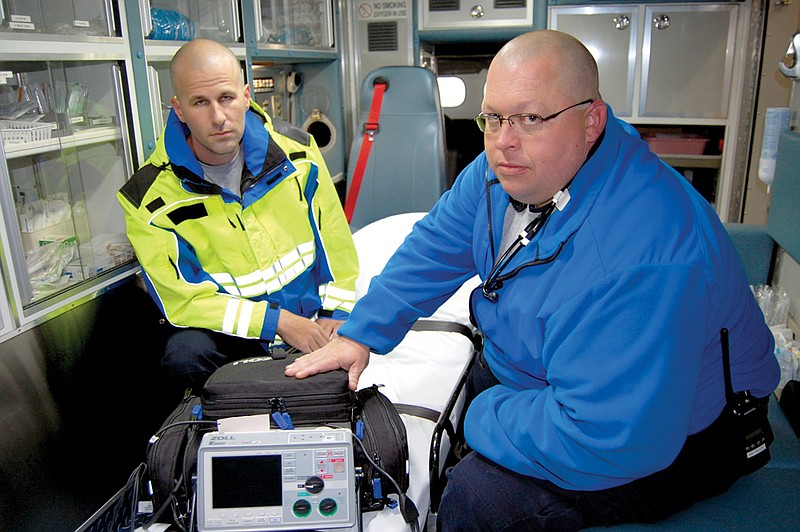BENTON — Time is everything for a person having a heart attack.
“Time lost is muscle lost,” said Dr. Scott Archer, emergency department medical director at Saline Memorial Hospital In Benton.
It is a common saying in cardiac medicine because when blood flow to the heart is blocked with a myocardial infarction, the most common type of heart attack, the heart muscle is deprived of oxygen and can be permanently damaged. So, a patient’s chance of survival depends on the hospital’s ability to quickly assess and treat the blockage.
With specialized equipment, trained personnel and a rapid response, Saline Memorial Hospital has reported that its emergency and cardiac units have met the lifesaving timelines 100 percent of the time since April 2011.
Archer said medical personnel have no more than 90 minutes from the time someone calls 911 or enters the hospital to when they reopen the blood flow with a balloon inflated into an artery at the blockage site.
This coordinated effort cuts the time it takes for a patient to go from the hospital door to the balloon, known as “D2B,” and is “a well-choreographed dance that moves smoothly and quickly,” said Matt Brumley, ambulance service director for Saline Memorial.
“This vigilance and cooperation between the ambulance service, the emergency department and the heart-catheterization lab has literally saved the lives of multiple patients,” Archer said.
According to information from the American Heart Association, every 34 seconds, someone in this country has a myocardial infarction. While some are dramatically intense and sudden, some heart attacks start slowly with mild pain or discomfort.
“Some people can have silent heart attacks, and they just think their stomach’s upset,” Brumley said. “People aren’t always sure what’s wrong and wait too long before getting help.”
Some heart-attack warning signs may include symptoms that are mistaken for other ailments, according to the heart association. These are discomfort in the chest or other areas of the upper body, shortness of breath, cold sweats, nausea and lightheadedness.
Brumley suggested that anyone who experiences these symptoms should call 911.
It is almost always the fastest way to get lifesaving treatment. Emergency medical personnel can begin treatment when they arrive, up to an hour sooner than if someone gets to the hospital by car, according to information released by the hospital.
“When our ambulance team arrives on-scene and identifies a patient with potential heart-attack symptoms, we realize immediately we are in a race against time,” Brumley said. “With the addition of cardiac monitors onboard the ambulances, we can send 12-lead ECGs (electrocardiograms) from the patient locations so the emergency department will be prepared and [personnel] in place when the patient arrives.”
The portable cardiac monitors were installed in Saline Memorial ambulances in 2010. They were purchased by the Saline County Medical
Foundation from funds raised at an annual golf tournament.
When it has been established that a patient has had a heart attack, the heart catheterization lab is notified, Archer said.
“If they are not already at the hospital, the team can be assembled in 30 minutes or less,” he said. “Meanwhile, in emergency, we’ll put in an IV line and give medications like aspirin and nitroglycerin, depending on what kind of heart attack it is, take labs and stabilize blood pressure and rhythm.”
Once heart-attack patients arrive by ambulance, Archer said, they can go through the emergency department to the cath lab in five minutes. Brumley said D2B time is often less than 50 minutes and is sometimes in the 30-minute range.
Archer said catheterization with a balloon is the answer for most heart attacks caused by clogged arteries.
“If there are multiple clogs, then the patient might need bypass surgery,” he said. “It depends on how bad it is. If it is a small blood vessel, it might be treated with medicines. Most of the cases we see use the balloon procedure.”
Julie Myrick, lead nurse for the SMH cath lab, said the cardiac catheterization team works closely with emergency staff, intensive-cardiac-care-unit personnel and other departments to ensure the best and fastest care possible.
“It takes everyone working together,” said Brumley, who is also head of the medical foundation. “Even the housekeeping department knows that if the cath lab is in use and another heart attack patient is coming in, they can come in after one procedure and get everything ready for the next patient as soon as possible.
“This was something the hospital wanted to accomplish, and now it is a reality. This effort has impacted lives and made for a better quality of life for many people.
“I’m proud we were able to push the envelope and strive to be the best at what we do.”
Staff writer Wayne Bryan can be reached at (501) 244-4460 or wbryan@arkansasonline.com.
